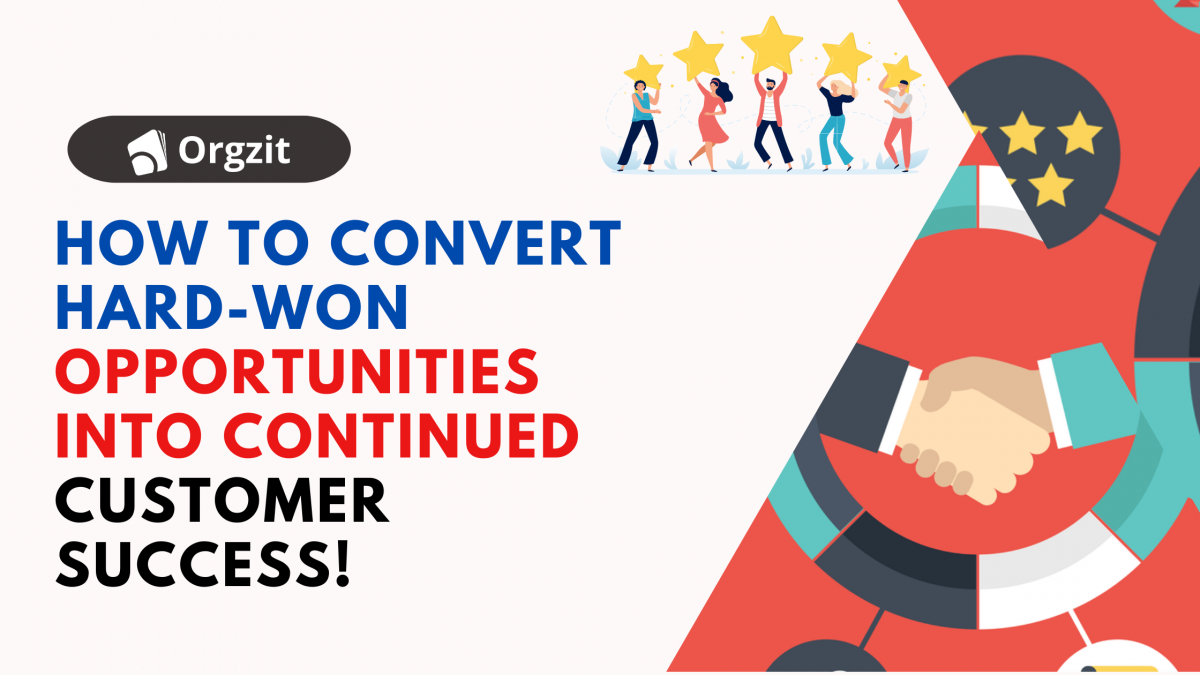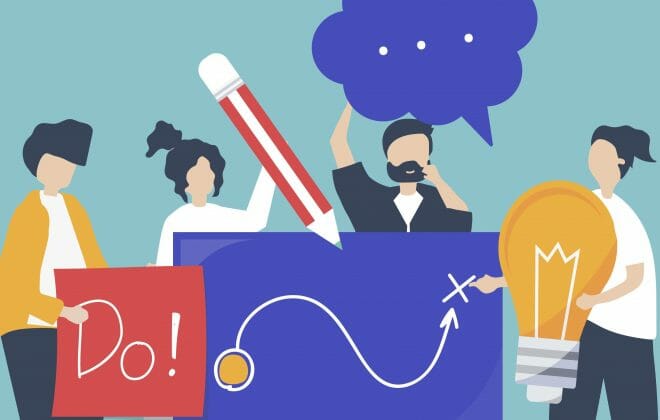How to convert hard-won opportunities into continued customer success!
In business, opportunities do not always come easily. Sometimes, they present themselves only after tremendous hurdles and tireless effort.
Every opportunity won is like striking gold, especially when it feels like we’ve had to dig deep to crack the tough ones. Whether it’s dealing with a skeptical buyer, a risk-averse customer, or a price-conscious shopper, as a sales manager, your task is to understand and address their concerns effectively, aiming to win their trust and close the deal.
But once you have closed the deal, that’s where the real deal begins.
The Harvard Business Review research report shows that increasing customer retention rates by 5% increases profits by 25–95%.
Winning an opportunity is challenging in itself, and the feeling of finality that comes with closing a deal can be natural.
However, it’s important to recognize that true success extends far beyond the initial sale. Long-term customer satisfaction and retention are essential for sustained profitability.
Furthermore, their happiness and advocacy help to build favorable brand awareness and reputation, which boosts the company’s long-term growth potential.
But, ensuring customer retention is not an easy task, primarily because of challenges like competition, evolving customer needs, and maintaining consistent value delivery.
Someone said if you can turn a new customer into a repeat buyer, then your product is doing its job.
However, if you can turn a customer into a fan of your company and product, then you are doing your job well!
3 Major mistakes to avoid
Some of you might already know the importance of lasting relationships and customer retention even before reading this blog, but have you ever wondered why it isn’t working out for you?
It’s simply because you are making these three mistakes over and over again!
Those three major pitfalls are:
- Neglecting the Growth of Long-Term Customers:
- Falling to a sense of finality when closing opportunities
- Failing to follow proper KYC (Know Your Customer) protocols
Let’s discuss and understand these issues in detail.
Neglecting the Growth of Long-Term Customers:
The biggest mistake the sales team makes is focusing entirely on making the initial sale without considering the lasting effects.
While acquiring a new customer is certainly a great achievement, the true value is in developing long-term relationships that lead to recurring business and referrals.
Let’s understand this better by considering an example of a company that;
- Invests hundreds of hours and considerable resources in acquiring a new client.
- But as soon as the transaction is completed, they shift their emphasis to the next opportunity, failing to nurture the newly acquired consumer.
- As a result, the consumer feels undervalued and ignored, which leads to discontent and eventual turnover.
Thus, overlooking the development of long-term customer relationships not only reduces revenue potential but also undermines brand loyalty and reputation.
To avoid making this error, what you can do is prioritize;
- ongoing engagement,
- frequent communication and feedback
- post-purchase support
For this, you can create an onboarding plan, or a welcome kit to help the customer at every single step of their buyer journey.
💡 Track your onboarding plan for every new customer and record post-onboarding feedback. This will help you demonstrate your business’s dedication to customer success beyond the initial sales transaction.
Sense of Finality in Closing Opportunity:
One common mistake many salespeople make is considering the closure of a sale as the end of the road. However, this shortsightedness may lead to missed opportunities for upselling, cross-selling, and deeper engagement with customers.
Imagine for an instant: You’ve just successfully closed a deal with a manufacturing plant for a bulk order of machinery parts. As you finalize the transaction and prepare to leave, consider taking a more proactive approach.
Instead of simply wrapping up the deal and heading out, imagine if you continued to engage with the plant manager. You might inquire if they need any additional parts or accessories that complement their recent purchase. Perhaps you could suggest upgrading to a higher-quality material for enhanced performance or offering a maintenance package to ensure the longevity of their investment.
By maintaining this level of engagement even after the initial sale, you not only create opportunities to increase revenue for your company but also deepen your relationship with the client, positioning yourself as a trusted advisor rather than just a salesperson.
It’s about seizing every opportunity to add value and enhance customer satisfaction, laying the groundwork for long-term success.
💡 Rather than viewing each sale as the ultimate aim, field sales reps should see it as the foundation for future expansion and collaboration. They can maintain momentum and generate long-term customer satisfaction and loyalty by continually delivering value and looking for new ways to collaborate.
Not Doing Proper KYC (Know Your Customer):
The biggest mistake that sales reps must avoid is neglecting to conduct thorough KYC (Know Your Customer) procedures before pursuing opportunities.
Failing to understand the needs, preferences, and pain points of potential customers can result in misaligned offerings and missed opportunities for personalized engagement.
Now I want you to think about that one time you just rushed into a sales pitch without first conducting comprehensive research on the prospect’s industry, challenges, and objectives.
As a result, you presented generic solutions that failed to resonate with the lead’s specific needs, leading to a lost opportunity and wasted resources.
That is why, to save you from a BP shoot and a lost opportunity, a proper KYC is essential. It is useful for successfully targeting, engaging, and converting, prospects into satisfied customers.
Businesses that understand their customers’ unique business contexts can always adjust their strategies and services to address their unique pain points, all while maximizing value.
This not only raises the likelihood of a successful transaction but also builds the framework for long-term relationships based on trust and mutual understanding.
7 Essential Tactics To Ensure Long-Term Customer Success!
1. Do not work on a pipeline
While focusing on building a pipeline, potential customers can merely be treated as numbers. Focusing on closing any deal can lead to poor lead qualification. A poor-quality lead may not be an ideal buyer for your company. They may be dissatisfied easily, pay you less, and eventually be difficult to retain.
If a sales rep is too focused on closing the sales deal, they may also predict the wrong sales forecast or fail to build a relationship with the customer.
By nurturing relationships rather than simply pursuing a transaction, you set the groundwork for long-term trust, commitment, and improved customer retention.
2. Check for onboarding requirements
Effective onboarding lays the groundwork for a successful, long-term relationship.
Before closing the deal, make sure you thoroughly understand the client’s onboarding needs. Whether it’s providing training sessions, offering implementation support, or guiding them through technical setup.
Addressing these requirements upfront shows that you’re committed to their success from the start.
For instance, if a client expresses concern about integrating your software with their existing systems, assure them of your team’s expertise in seamless integration and share a transparent plan of action, easing their worries and laying the groundwork for a long-term partnership.
3. Pre-conceive the end customer training
Anticipate your clients’ training needs and have a plan in place to provide them.
Proactive training programs, whether it’s
- providing step-by-step instructional videos
- hosting interactive webinars
- arranging personalized, on-site workshops
enable clients to get the most out of your product or services.
For instance, if you’re selling a new software platform, try to offer — customized tutorials and live demonstrations — to help users navigate the system easily and effectively,
This will empower them to become proficient users and lead to satisfaction for them and customer retention for you.
4. Help the customer build connections with key rep firm personnel
Create real ties between your customers and key rep firm personnel who will be responsible for continuous support and account management.
Encourage open communication lines and schedule regular check-ins to discuss questions, concerns, and feedback.
To begin with, you can set up personalized introductory meetings between clients and assigned account managers to establish rapport.
This will ensure that your clients feel supported throughout their journey, building a collaborative partnership built on trust and accessibility.
5. Transparency on lead times, pricing, delivery, and special handling instructions
Transparency instills trust and confidence in your business.
Ensure transparency in your business dealings by openly communicating lead times, pricing details, delivery schedules, and any special handling instructions right from the start.
Avoid unexpected or hidden fees. By providing clear and accurate information upfront, you:
Build trust with your clients and mitigate the risk of misunderstandings or dissatisfaction.
For example, when quoting a project to a client, outline the expected timeline for completion, the breakdown of costs, and any specific requirements for delivery or handling, demonstrating your commitment and reliability in every transaction.
💡 Setting realistic expectations and delivering on your promises, demonstrates dependability and honesty, both of which are key ingredients for long-term customer retention and loyalty.
6. Follow up after delivery as promised
Don’t let the relationship fade after the sale is completed.
- Promptly follow up with clients post-delivery.
- Ensure their satisfaction with the purchased product or service.
- Address any concerns or issues swiftly.
- Prioritize their experience and feedback.
For example, you can send a personalized email or make a courtesy call to gather feedback and offer assistance, reinforcing your intent to provide exceptional customer service.
7. Staying agile and active on feedback
Feedback is an excellent source of wisdom for continual improvement. Actively collect feedback from customers at all stages of their experience, from initial sales to ongoing
support and beyond.
Actively listen to their input, whether it’s about problems, suggestions, or praise, and then take meaningful actions to enhance their experience.
For example, you can conduct regular surveys or feedback sessions to solicit insights and ideas directly from customers.
Read here on the importance of customer feedback in detail: Customer Satisfaction and its Importance
💡 Regular post-sale communication and valuing customer feedback demonstrate your commitment to client service, set up the basis for a long-term connection, and result in customer retention.
Key Takeaways
- The journey from discovering a prospect or potential opportunity to converting it into a loyal, long-term customer is anything but easy.
- While acquiring a new customer is certainly a great achievement, the true value is in developing long-term relationships that lead to recurring business and referrals.
- A loyal customer can provide recurrent business and referrals in addition to the instant revenue provided by the initial sale.
- Overlooking the development of long-term clients, falling into a sense of finality when closing opportunities, and failing to follow proper KYC (Know Your Customer) protocols can all hinder the capacity to cultivate long-term relationships and maximize the value of every opportunity.
- Instead of viewing each sale as the ultimate aim, businesses should see it as the foundation for future expansion and collaboration.
- Failing to understand the needs, preferences, and pain points of potential customers can result in misaligned offerings and missed opportunities for personalized engagement.
- To avoid making these errors, organizations should prioritize ongoing engagement, communication, and post-purchase support to demonstrate their dedication to customer success beyond the initial sale transaction.
Winding Up!
Converting your opportunities into long-term customer success and increasing the customer retention rate is quite an uphill battle of turning fleeting chances into long-term wins.
It requires a great deal of effort through personalized experiences, proactive support, steadfast dedication, and technology adaptation.
To sum it all up, we can say that only businesses that focus on developing trust, delivering value, and cultivating continuing engagement can improve customer retention, generate revenue growth, and increase their competitive advantage even in today’s dynamic environment.
Get a free personalized consultation and see how easy it is to convert leads into lifelong customers!
FAQs
For customers, their own success comes first.
Connect with the customers at a human level. Empathy is how we build trust. Set the right expectations, and be transparent and responsive.
The three major goals of customer success are;
– renewals,
– customer retention, and
– revenue expansion
These results come from happy customers who have their needs and goals fulfilled.
You can retain customers by implementing strategies like:
1. Smooth onboarding process.
2. Be transparent about pricing and delivery times.
3. Create a customer feedback loop
Beyond closing a deal, businesses should continue customer engagement by following up after delivery, providing ongoing support, and constantly seeking ways to add value and improve the customer experience.









